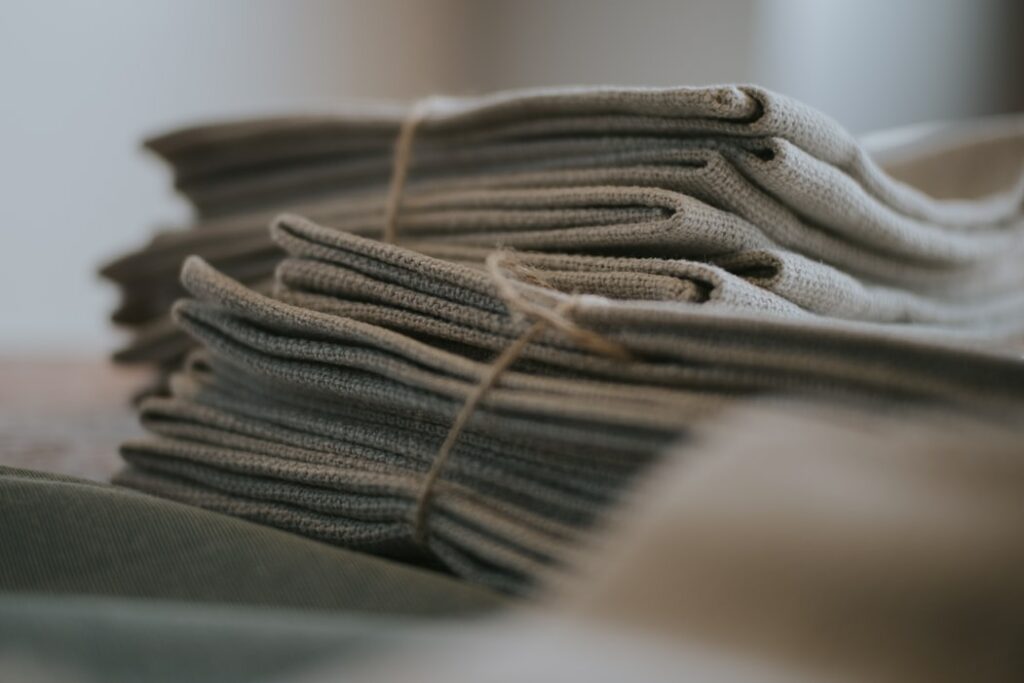Hemp is becoming a popular source for many brands as a greener, more eco-friendly fabric, which is exciting since we probably have yet to see hemp’s full potential as a textile.
This is because the path to mainstream hemp has been hindered by stigmatized associations with marjuana. However, with agricultural regulations having loosened up over the years, we’re starting to see the benefits of using hemp over other fabrics.
Read further to understand what hemp fabric is and how sustainable it can be.
What is Hemp Fabric?
Hemp Plant Source
Hemp fabric is made from the fibers of stalks in the Cannabis sativa plant. It is a type of bast fiber, like flax, jute, and kenaf, which designates its outer bark as having strong cellulosic fibers.
Cannabis sativa is primarily bred for two reasons: first, to be high in tetrahydrocannabinol (THC) and other psychoactive chemical constituents called cannabinoids. And second, to produce strong fibers for hemp products.
Hemp textiles come from the latter, which is also called industrial hemp. These crops are cultivated with intentional low levels of psychoactive cannabinoids (having no more than 0.3 percent THC on a dry weight basis as defined by the FDA). Only within the past decade have these hemp plants become legal to grow in the US under federal law.
Properties of Hemp
Hemp has been cultivated for thousands of years. Notably, it makes for an incredibly strong fiber, demonstrated by its historic use for ropes and sailing, and especially when compared to cotton and synthetic textiles. For example, hemp is estimated to be three times stronger than cotton.
Pros and Cons of Hemp Fabric
Pros:
- Highly durable
- Lightweight
- Moisture-wicking
- Doesn’t shrink
- Resistant to mold and mildew (great for humid climates)
- Simple and efficient to produce with less environmental impact than cotton
Cons include:
- The texture is on the rougher side, sometimes feeling like canvas. However, hemp should soften up after a few washes without degrading fibers. Blends with hemp are also popular to soften it up, such as hemp-cotton and hemp-silk blends.
- It’s expensive. But since this is due to market forces that drive the price up, hemp’s increasing popularity may lead to decreased costs in the future.
- Less able to be dyed in rich colors
- Wrinkles easily
Is Hemp Fabric Sustainable?
The short answer is that hemp fabric is, for the most part, a sustainable and eco-friendly fabric. Ahead, we break down components such as growing and manufacturing hemp to show why this fabric is sustainable.
Growing Hemp
The environmental benefits of hemp are quite clear considering its cultivation. Industrial hemp is also a profitable crop.
Industrial hemp naturally suppresses weeds, so no chemical herbicides are needed to control unwanted plants. There are few biological pests that affect hemp, so less, if any, pesticides are required. This is significant because herbicides and pesticides contribute to more than one half of the energy in farming.
In addition to avoiding chemical treatment, hemp improves soil quality because it returns nutrients to the soil and can even restore damaged soils.
According to Slate, although cotton requires less energy to grow, hemp wins on yield and water usage. This is because hemp has a high yield, which means you can grow more with less land. Hemp also requires 50 percent less water to grow than cotton, and is a fast growing plant.
This all being true, farmers may still choose to use herbicides, pesticides, and fertilizers that are damaging to the environment while growing hemp. Because of this, it is still best practice to look for organic hemp.
Manufacturing Hemp
Once the industrial hemp is harvested, the stalk of the hemp is separated before further processing. Because hemp is a bast fiber, like flax (linen), outer fibers are stripped from the woody core of the stalk through retting.
Next, there are mainly two different routes to go: mechanical or chemical manufacturing. Mechanical manufacturing evolves from centuries-old traditional hemp production.This remains relatively eco-friendly because it involves machinery rather than chemicals.
However, modern manufacturers, particularly in China where 70% of hemp is produced, rely on chemical methods because it is faster, cheaper, and less labor-intensive.
The fibers are then spun into yarn, which is basically the same for either chemically or organically processed hemp. The amount of chemicals in the softening of hemp depends on the producer’s desire for smooth texture versus hemp’s original roughness.
Fortunately, due to natural features and brightness, hemp does not require chlorine and can use biodegradable versus toxic cleaning products.
Regarding dyes, hemp can be made with natural dyes, which is essentially no dye, and looks like a beige color.
Bottom Line
Hemp is arguably one of the most eco-friendly fabrics out there and has a persuasive business case for its profitable potential. This is because of industrial hemp’s low environmental impact and high crop yield.
Hemp garments definitely have a character to deal with given its rough texture and neutral colors, but hemp is rising into the mainstream with advancing technologies in production and consumer desires. That being said, there are plenty of modern and chic clothing already out there to add to a sustainable wardrobe.
You can check out brands like WAMA, Afends, Valani, Back Beat Co., and Patagonia. Certifications to look for include USDA or EU organic hemp, GOTS, and Ecocert (OCS 100) labels.

